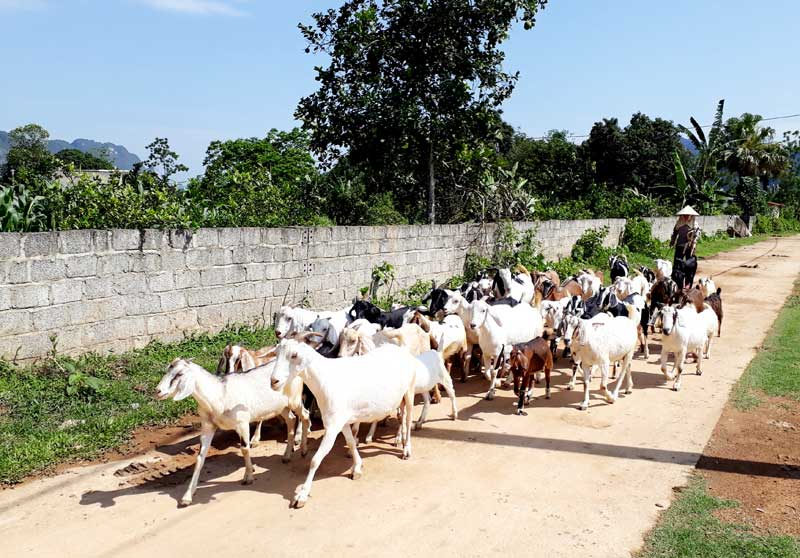
(HBO) - The goat has been very popular with farmers in Dong Tam commune (Lac Thuy) for many years. Goat breeding is one of the widely - focused directions in Dong Tam commune.
Currently, the commune has about 100
households in 10/16 hamlets and villages, which are maintaining to raise goats,
the total number of herds is approximately 2,000 animals.
In Dong Tam, there are 3 kinds of goats
raising, including mountain goats, Boer goats and Bach Thao goats. Among them,
goats are being raised most in the hamlets of Ngoc Lam, Dai Dong, Dong De, Dong
Danh. Many households in these hamlets have goat litters up to 50 - 60 animals,
such as: the households of Trinh Ngoc Hung, Nhu Van Vu, Pham Van Toi in Ngoc
Lam village; Mr. Vu Van Hung (Dai Dong village), Nguyen Van Nhan in Dong De
village.

The goat litter of nearly 60 animals of Mr.
Nguyen Van Nhan's family, Dong De village.
Previously, Mr. Nguyen Van Nhan's household
in Dong De village had only 5 breeding goats. Every day, in the morning, his
family released goats to the mountains, and in the afternoon they collected
them back to the cage. Due to suitable grazing conditions, the goat population
rapidly developed. Up to now, Nhan's family has 60 goats, of which 20 goats are
breeding. Thanks to raising goats, each year he earns a stable source of income
for his family.
Ms. Nguyen Thi Lien, Nhan's wife, shared:
"Goat feeding is very suitable and not as hard as other animals. In order
to let goats develop well, we need to obtain the basic techniques in caring and
protecting goats from easily caught diseases. In general, goats should be
released to the mountain in the morning; in the afternoon, they come back to
their cages. We only feed goats with salt water, bran and corn for good
development.”
In Ngoc Lam village, Ms. Bui Thi Lan's family
is one of the typical goat raising households. Previously, when the output of
the goat was very unstable, Ms. Lan's family only raised on a small scale. After
that, when the market is stable, the price of Dong Tam goats is often higher
than other regions, Ms. Lan's family decided to borrow money to build cages and
buy more goats for breeding. So far, the goat litter of her family has
increased to nearly 60 animals, which brings a stable source of income over 100
million VND each year.
The Department of Education and Training of Hoa Binh province held a conference on March 18 to review the performance of the "Safe and Happy School" Project and set out tasks for 2025. The project, funded by the Taiwan Fund for Children and Families (TFCF), aims to create a safe, inclusive, and supportive learning environment for students. The event saw the attendance of representatives from the TFCF and 26 beneficiary schools.
With over 70% of their workers being women, trade unions across industrial parks (IPs) in Hoa Binh have been actively safeguarding their legal rights and interests while implementing initiatives to improve their income and well-being.
In recent years, the Hoa Binh provincial General Hospital has continuously innovated itself and improved the quality of medical services to meet the increasing needs of local people. With substantial investments in infrastructure and modern equipment, along with a team of highly qualified doctors and nurses, the hospital has gradually established itself as one of the leading medical units in the Northwestern region and a trusted destination for healthcare for people inside and outside the province.
From mastering the fundamentals of programming to achieving national recognition, the Programming Club of the Le Van Tam Primary School (STAR LVT28) in Hoa Binh city has made remarkable strides in the field of robotics.
The Ho Chi Minh Communist Youth Union Committee and the Vietnam Youth Federation chapter of Hoa Binh province organised a programme on March 12 to launch the "Digital Literacy" movement and an online quiz on the resolutions of the Vietnam Youth Federation congresses at all levels, as well as the Politburo's Resolution No. 57-NQ/TW on breakthroughs in the development of science, technology, innovation, and national digital transformation.
As climate change grows more unpredictable, the development of production forests has become essential - not just for economic growth, but for safeguarding the environment and maintaining ecosystem balance. By boosting local incomes, curbing natural disasters, preventing soil erosion, and protecting water resources, these forests play a crucial role in sustainable development.



